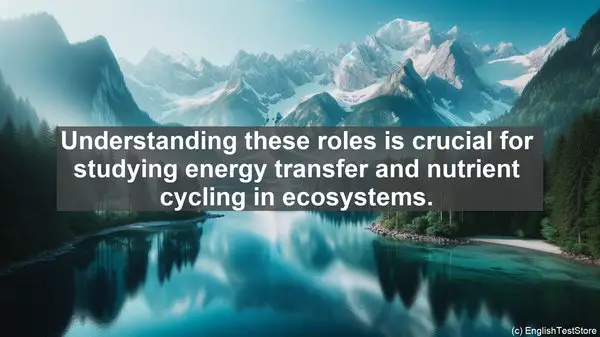Introduction: The Importance of Accurate Terminology
Welcome to our channel. Today, we’re going to discuss a topic that’s often overlooked but is of utmost importance in the field of Functional Ecology – accurate terminology. Words have the power to convey precise meanings, and in a scientific discipline like Functional Ecology, this becomes even more crucial. Misunderstanding or misusing a term can lead to misinterpretation of data, flawed conclusions, and even hinder the progress of research. So, let’s not waste any more time and jump right into the top 10 commonly confused words in Functional Ecology!

1. Niche vs. Habitat
The terms ‘niche’ and ‘habitat’ are often used interchangeably, but they have distinct meanings. A habitat refers to the physical environment where an organism lives, including the biotic and abiotic factors. On the other hand, a niche is the role or position an organism has within its habitat, encompassing its interactions, behaviors, and resource utilization. Understanding the difference between these two terms is crucial for studying species’ adaptations and their ecological relationships.
2. Population vs. Community
While ‘population’ and ‘community’ both refer to groups of organisms, they differ in scale. A population consists of individuals of the same species living in a particular area, whereas a community includes multiple populations of different species coexisting in the same area. By studying populations, we can understand factors influencing species’ abundance and distribution, while the study of communities provides insights into species interactions, such as competition or predation.
3. Ecosystem vs. Biome
Often used interchangeably, ‘ecosystem’ and ‘biome’ are distinct ecological units. An ecosystem refers to a specific community of organisms and its physical environment, including the interactions between them. It can be as small as a pond or as vast as a forest. On the other hand, a biome is a broader regional-scale classification, characterized by similar climatic conditions, vegetation, and animal life. Examples of biomes include deserts, tundras, or rainforests.
4. Producer vs. Consumer
In the context of energy flow in ecosystems, ‘producers’ and ‘consumers’ play vital roles. Producers, often plants or algae, are capable of photosynthesis, converting sunlight into chemical energy. Consumers, on the other hand, obtain energy by consuming other organisms. They can be classified into different trophic levels, such as primary, secondary, or tertiary consumers, depending on their position in the food chain. Understanding these roles is crucial for studying energy transfer and nutrient cycling in ecosystems.
5. Biotic vs. Abiotic
The terms ‘biotic’ and ‘abiotic’ are used to describe the components of an ecosystem. Biotic factors refer to the living organisms, including plants, animals, and microorganisms, and their interactions. Abiotic factors, on the other hand, encompass the non-living components, such as temperature, sunlight, soil, or water. Both biotic and abiotic factors shape the structure and functioning of ecosystems, and studying their interactions is fundamental in understanding ecosystem dynamics.
6. Migration vs. Dispersal
Migration and dispersal are two forms of movement observed in organisms, but they differ in their patterns and purposes. Migration is a regular, often seasonal, movement of individuals from one location to another, usually for breeding or for accessing resources. Dispersal, on the other hand, refers to the movement of individuals away from their birthplace, often in search of new habitats or to establish new populations. Both migration and dispersal play crucial roles in species’ distribution and gene flow.
7. Symbiosis vs. Mutualism
While all mutualistic interactions can be considered as symbiotic, not all symbiotic interactions are mutualistic. Symbiosis refers to a close and long-term association between two or more species. Mutualism, a type of symbiosis, is a mutually beneficial interaction, where both species involved derive benefits. However, symbiotic interactions can also be commensalistic (one species benefits, the other is unaffected) or parasitic (one species benefits, the other is harmed). Understanding these different types of interactions is crucial for studying species’ coevolution and community dynamics.
8. Primary vs. Secondary Succession
Succession refers to the process of ecological change in a particular area over time. Primary succession occurs in a completely barren, often newly formed, habitat, such as a volcanic island. It starts with pioneer species, like lichens or mosses, and gradually progresses to more complex communities. Secondary succession, on the other hand, occurs in habitats that have been disturbed, but still retain some soil and seed bank. Understanding these successional processes is essential for habitat restoration and conservation efforts.
9. Keystone Species vs. Indicator Species
Keystone species and indicator species are both important in ecological studies, but they have different roles. A keystone species has a disproportionately large impact on its ecosystem, often through its interactions with other species. Its removal can lead to significant changes in the community structure. Indicator species, on the other hand, are used as indicators of environmental conditions. Their presence or absence can provide insights into the health or quality of an ecosystem. Both types of species are valuable in conservation and management strategies.

10. Invasive vs. Native Species
Invasive species, as the name suggests, are non-native species that have been introduced to a new area and have negative impacts on the native biodiversity. They often outcompete native species for resources, disrupt ecosystem processes, and can even lead to the extinction of native species. Native species, on the other hand, are naturally occurring in a particular area. Understanding the dynamics between invasive and native species is crucial for effective invasive species management and biodiversity conservation.
